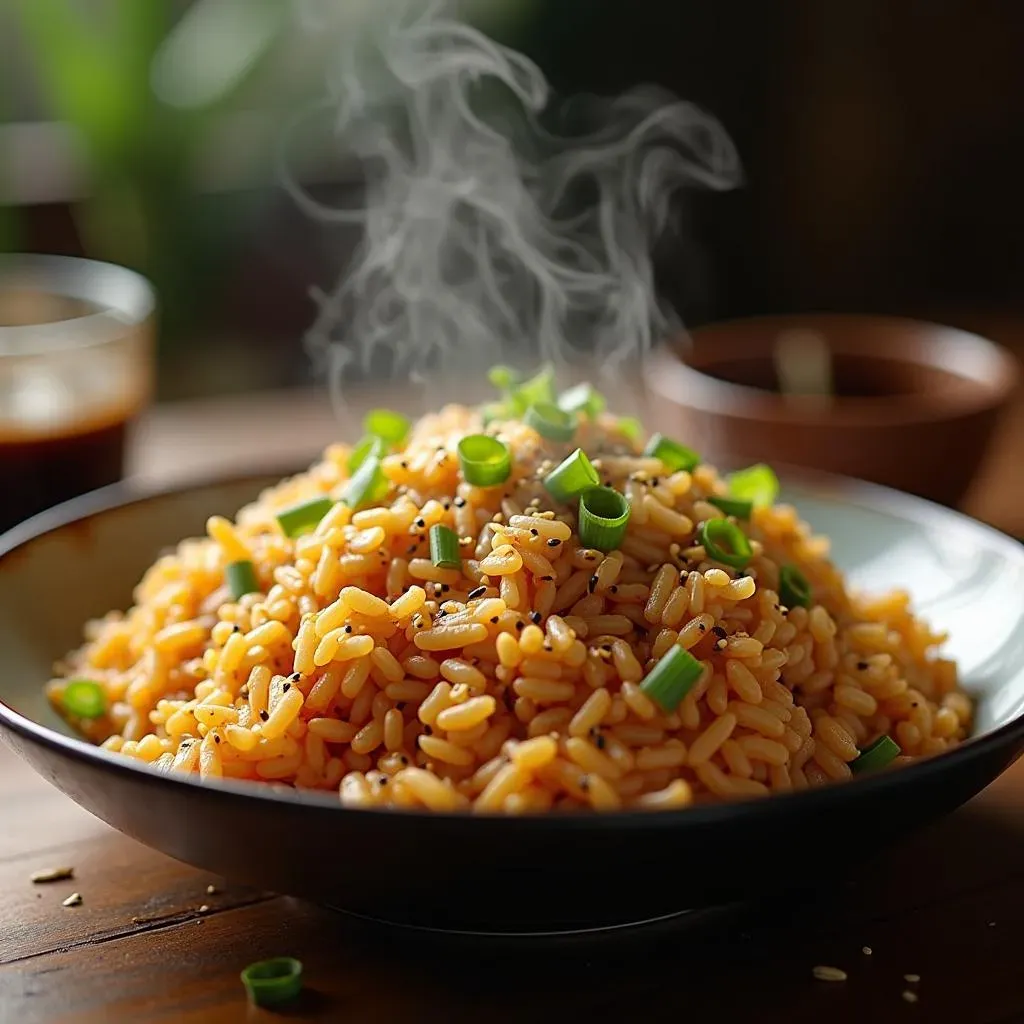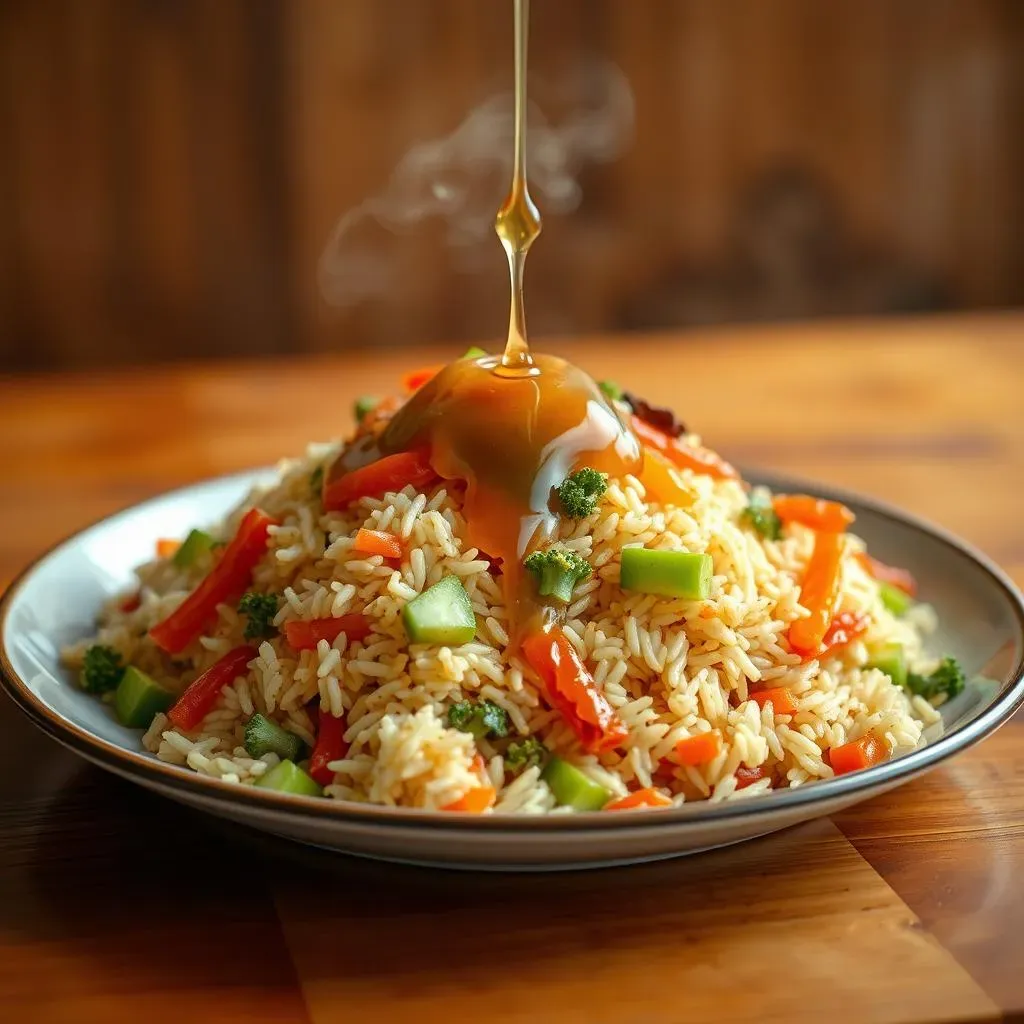Table of Contents
Let's be real, fried rice is a blank canvas, a culinary playground just waiting for the right flavors. But the big question always lingers: what is the best condiment for fried rice? Is it the classic salty tang of soy sauce, or something more adventurous? I've been there, staring into the fridge, wondering how to take my fried rice from "meh" to "magnificent." This isn't just about dumping some random sauce on your plate. It's about understanding how different flavors interact with the rice, veggies, and proteins you've tossed in. In this article, we'll explore the core contenders – from the umami-rich soy sauce to the fiery kick of chili oil and even some sweet surprises. We'll look at how each one enhances your fried rice experience, so you can finally stop guessing and start creating fried rice that sings with flavor. So, buckle up, grab your chopsticks, and let's find your perfect condiment.
Soy Sauce: The Undisputed King of Fried Rice

Soy Sauce: The Undisputed King of Fried Rice
The Salty Foundation
Okay, let's talk soy sauce, the MVP of fried rice. It's that salty, umami-packed liquid that’s more than just a condiment. It's the backbone of the dish. I remember the first time I made fried rice without it, it was bland and lifeless, like a sad pile of rice grains. Soy sauce doesn't just add salt; it brings this depth of flavor that makes everything else pop. It's like the bassline in a song, you might not always notice it, but without it, the music just isn't the same.
Varieties and How to Use Them
Now, not all soy sauces are created equal. You've got your light soy sauce, which is thinner and saltier, perfect for adding that initial punch. Then there's the dark soy sauce, which is thicker and sweeter, bringing a richer color and a slightly molasses-like taste. I tend to mix them, a splash of light for the salt and a dash of dark for the depth. It's like having a secret weapon in your kitchen. Don't be shy, experiment with different ratios and find what works best for your taste buds. You can also use low sodium soy sauce if you are watching your salt intake.
Soy Sauce Type | Flavor Profile | Best Use in Fried Rice |
|---|---|---|
Light Soy Sauce | Salty, Thin | Initial seasoning, adds saltiness |
Dark Soy Sauce | Sweet, Rich, Thick | Color and depth of flavor |
Low Sodium Soy Sauce | Salty, Thin | For those watching salt intake |
Tips for the Perfect Soy Sauce Integration
Timing is everything when it comes to adding soy sauce. I like to drizzle it in towards the end of the cooking process, when the rice is already hot and the other ingredients are nearly cooked. This way, it doesn't get diluted and each grain of rice can soak it up properly. Don't pour it directly on top of your rice, instead drizzle it around the edge of the pan, allowing it to sizzle and mix with the other ingredients. It's the small details that elevate your fried rice game from amateur to pro. Trust me, your taste buds will thank you.
Beyond Soy: Exploring Other Savory Options for Fried Rice

Beyond Soy: Exploring Other Savory Options for Fried Rice
Alright, so soy sauce is like the reliable friend you always call on, but what if you want to spice things up? What if you're craving a flavor that’s a little less predictable? That’s where the fun begins. There's a whole world of savory options out there that can take your fried rice to new heights. Think of it as adding new characters to your favorite story; each one brings a different dynamic. I remember when I first started experimenting, I was blown away by how a single ingredient could completely transform the dish.
Let’s start with oyster sauce, this is not just for stir-fries. It adds a rich, slightly sweet, and deeply savory flavor that’s really something special. Then there's fish sauce, which might sound a little scary, but trust me, a tiny splash can add a serious depth that you never knew your fried rice was missing. It’s like adding a secret ingredient that makes people go "Wow, what is that?" Don't be afraid to try hoisin sauce too, it’s sweet, salty, and a little bit tangy, bringing a complex flavor profile that pairs well with a variety of ingredients. It is like a flavor bomb that explodes in your mouth.
Savory Sauce | Flavor Profile | How to Use in Fried Rice |
|---|---|---|
Oyster Sauce | Rich, Sweet, Savory | Add a tablespoon for depth |
Fish Sauce | Salty, Umami | Use sparingly, a few dashes is enough |
Hoisin Sauce | Sweet, Salty, Tangy | Mix in a teaspoon or two |
And don’t forget about the umami power of a good quality mushroom sauce. It gives you that earthiness that some other sauces lack. It’s like bringing a little bit of the forest to your kitchen. These options are perfect for those looking to move beyond the usual, offering a flavor experience that's both unique and satisfying. Each one of these adds a different layer, so you're not just eating fried rice, you're experiencing it.
Sweet Sensations: Adding a Touch of Sweetness to Your Fried Rice

Sweet Sensations: Adding a Touch of Sweetness to Your Fried Rice
The Unexpected Twist
Okay, so we've covered salty and savory, but let's talk about something that might surprise you: sweetness in fried rice. I know, it sounds a bit out there, but trust me, it's a game-changer. It's like adding a little sunshine to a cloudy day, that unexpected burst of flavor that makes your taste buds do a happy dance. I used to think fried rice was strictly a savory dish, but then I tried a version with a touch of sweetness, and it blew my mind. It's all about balance. It isn't about turning your fried rice into dessert, but about adding a little something extra that makes all the other flavors shine.
Sweet Options and How to Use Them
Now, when I say "sweet," I'm not talking about dumping a load of sugar into your pan. We're going for subtle, nuanced sweetness. Think about using a touch of honey or maple syrup. These aren't just for pancakes. A drizzle at the end of cooking can add a lovely richness and depth. I once added a tiny bit of maple syrup to my fried rice, and it made it taste like it came from a fancy restaurant. Then there's the option of using a sweet chili sauce. It brings both sweetness and a gentle heat, creating a flavor combo that's hard to resist. It’s like a party in your mouth, where everyone is invited.
Sweet Ingredient | Flavor Profile | How to Use in Fried Rice |
|---|---|---|
Honey | Floral, Sweet | Drizzle a small amount |
Maple Syrup | Rich, Caramel-like | Add a teaspoon or two |
Sweet Chili Sauce | Sweet, Spicy, Tangy | Mix in to taste |
Tips for Sweetening Your Fried Rice
The key to adding sweetness is to start small. It’s always easier to add more than to take away. I like to drizzle my sweet element right at the end, just before serving. This way, it doesn't get cooked down and lose its flavor. Another thing, make sure the sweetness you choose complements the other flavors. If you've got a lot of savory elements, a touch of honey or maple can really tie it all together. Don't be afraid to experiment; it's your kitchen, your canvas. And who knows, you might just discover your new favorite way to enjoy fried rice.
Spicy Kick: Elevating Fried Rice with Heat

Spicy Kick: Elevating Fried Rice with Heat
The Allure of Heat
Alright, let’s talk about adding some fire to your fried rice. I mean, who doesn't love a little kick? It’s like adding a jolt of energy, waking up your taste buds and making the whole experience more exciting. I remember the first time I tried fried rice with a proper dose of spice, it was like discovering a whole new dimension of flavor. It wasn't just about making it hot; it was about adding depth, complexity, and a bit of a thrill. It's like adding a drum solo to your favorite song, it just makes everything more intense.
Spice Options and Their Impact
Now, when it comes to heat, you’ve got options. We aren’t just talking about any old hot sauce. Let's start with Sriracha, the rooster sauce. It's got that garlicy, vinegary heat that's just perfect for fried rice. Then there's chili oil, which is more than just heat; it's got this amazing aroma and a rich, oily texture that coats every grain of rice. It is like adding velvet to your dish. And let's not forget about gochujang, the Korean chili paste. It brings a unique fermented flavor along with a deep heat that is so satisfying. It’s like adding a secret weapon that transforms your dish completely.
Spice Ingredient | Flavor Profile | How to Use in Fried Rice |
|---|---|---|
Sriracha | Garlicky, Vinegary, Spicy | Drizzle on top or mix in |
Chili Oil | Aromatic, Oily, Spicy | Add a teaspoon or two |
Gochujang | Fermented, Deep, Spicy | Mix in a small amount |
Don’t be afraid to experiment with different types of chili flakes too. Some are fruity, some are smoky, and some are just plain hot. It’s like having an arsenal of flavors at your disposal. Remember though, not all heat is created equal. Some spices hit you right away, while others build slowly. So start small and add more as you go. It’s always easier to add than to take away. It is the small details that elevate your fried rice game from amateur to pro.
When adding spice, I like to incorporate it at different stages. I might add some chili oil while cooking the veggies for that deep infused flavor, and then drizzle some sriracha on top for a final kick. It’s all about layering the flavors, creating a complex taste that is both satisfying and exciting. It’s like building a flavor pyramid. Each layer adds something unique that makes the entire structure more interesting and robust. And who knows, you might just discover your new favorite way to enjoy fried rice.